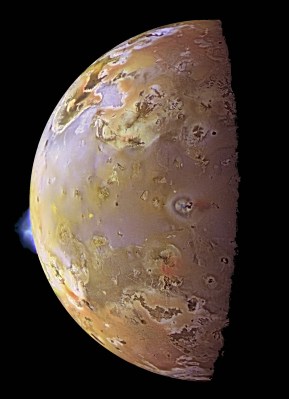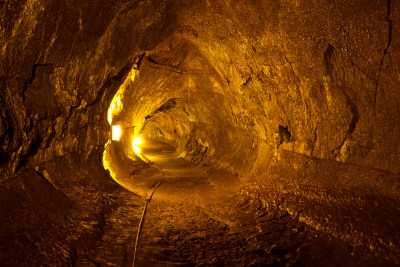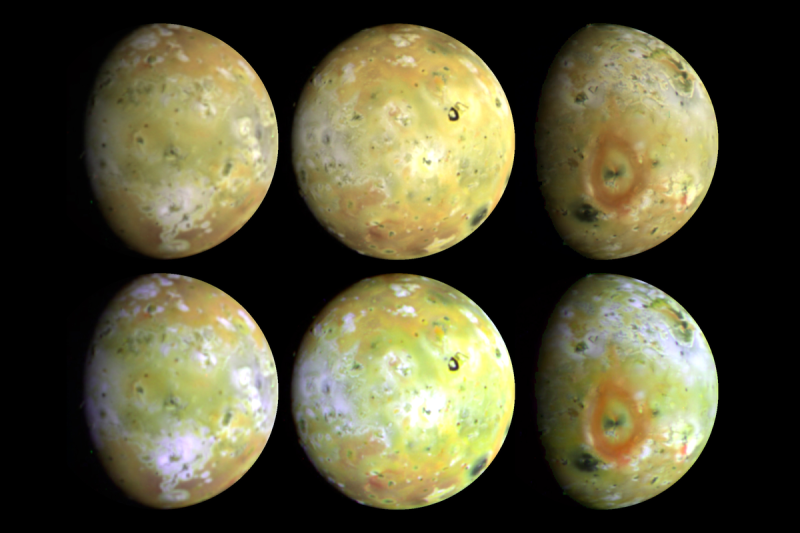It was many years ago now when David Bowie asked if there was life on Mars. Since then, we’ve concluded there isn’t, much to everyone’s disappointment. That left scientists the world over to start looking elsewhere for new lifeforms for us to talk to, conquer, or play bridge with. Or perhaps more likely, look at under a microscope.
The latest candidate for hosting nearby life is Jupiter’s moon, Io. Let’s take a look at what makes Io special, and what we might hope to find there.
The Pizza Moon
When it comes to places to search for life, Io hasn’t really been at the top of the list. Other moons of Jupiter, like Europa and Ganymede, have been considered far more likely candidates. That’s largely down to the fact that those moons play host to subsurface oceans. Given that we know life and water are so closely intertwined here on Earth, that has guided our search elsewhere. Saturn’s moon Enceladus has also been considered a strong contender, for a plume of methane erupting from its surface. It too plays host to subsurface oceans which could theoretically host life.

Io, in comparison, is a hot and volcanic place. New data collected by NASA’s Juno spacecraft suggests that despite this rugged, unhospitable exterior, Io could still host living things. On a recent flyby, Juno got within 80,000 km of the so-called “pizza moon,” and a future pass will get as close as 1,500 km. That’s set to update our knowledge of the moon significantly. Before Juno, our last visit to Io was with the Galileo spacecraft, over 20 years ago.
In size, Io is roughly comparable to the Earth’s moon, also known as “The Moon”. Io is wracked by volcanic activity though, with active lava flows on the surface, with mountain ranges and plains interspersed with calderas left over from volcanic eruptions. Being so distant from the Sun, Io can be very cold, at up to -130 °C in places. It’s nevertheless is an energetic place, with eruptions capable of shooting lava hundreds of kilometers from the surface.
In fact, near areas of volcanic activity, temperatures can reach up to 1,600 °C. The lava is kept hot and flowing thanks to the tidal forces experienced by Io, thanks to Jupiter itself and nearby moons Europa and Ganymede. It’s possible that the small moon may have once held water, like Europa or Ganymede, as ice was once common in its part of the solar system. However, a combination of radiation from Jupiter and the unrelenting tidal heating have likely long since driven away most of the water on Io, if any was once present.
Theories about life on Io center around the materials present and its unique environment. It’s believed that geothermal heat on the moon, combined with sulfur compounds, could serve as an energy source for simple microbial life. However, it’s unlikely these microbes would live on the surface, where temperatures are often well below freezing and radiation abounds. Instead, they could lurk within lava tubes beneath the surface. In fact, lava tubes commonly play host to microbes on Earth, all around the globe, so it’s conceivable that the same thing could happen on a distant rock far away in the solar system.
The difficulty for life on Io hinges on whether or not there is any water left on the desolate moon. Water serves as a solvent, and is involved in all manner of basic life processes for organisms on Earth. It’s abundant here, and the absence of water in an environment here largely coincides with an absence of life.

If water isn’t present, though, alternatives could exist. Hydrogen sulfide (H2S) is one possibility, with some similarities to the chemical behavior of water. It exists in a liquid form from -86 °C to -60 °C. Given the temperature profile on Io, liquid H2S could form in areas beneath the surface, particularly if subsurface channels were warmed by lava flows. Life could potentially exist in a spore-like form, where it springs to life when at the right temperature and in the right solvent environment, and going dormant when conditions aren’t so suitable. Bacteria on Earth can behave in such ways, so it’s not inconceivable for life to develop in this way elsewhere.
Of course, it’s all speculation at this point. The primary focus is on theories as to whether life could be on Io, rather than investigating if it currently is there or not. Proving the latter is a difficult task, and one that would likely require new space missions with a focus on doing the hard science necessary. Perhaps, though, a future generation will be the first to discover life teeming just beneath the scorched surface of the distant Pizza Moon.
Featured image: “Full Disk Views of Io” by NASA.
















Robert Heinlein wrote about it in 1950, Farmer in the Sky.
Atmosphere machines, gravity fields, and acomplicated process to turn lava into dirt for farming.
The discoveries of radiation emitted by Jupiter circa 1955 made that story obsolete.
*COUGH*
Science _FICTION_
*COUGH*
Is it really saying much that simple life could exist in our universe? Most simple sizes and shapes have high odds of survival as opposed to something more complicated.
Not really: part of the entire reason that life exploded on Earth was that it got complicated enough to be able to protect itself against changes. You need redundancy and error correction to deal with noisy environments, and a place like Io is a *massively* noisy environment.
I’m not really a big believer in “yes, this place is a hellhole but it’s not *that* much of a hellhole, and various forms of life exist in bad spots on Earth, too!” Extremophiles on Earth have the big advantage that they weren’t forced to evolve there – they’ve got this chemical library built up from life evolving in a more benign environment.
just want to push back on the word “concluded” to describe the search for life on mars. we’ve barely (and literally) scratched the surface. the search goes on. i’m sure people with a lot more information than i do have pretty strong suspicions about what we’ll find regarding current or past life, but i don’t think anyone should suggest the search is over!
Yah, came to ask what the author was even talking about regarding that.
There’s a really strong push to send humans to mars, just for the celebratory achievement like back in the Apollo days. Bear in mind, during Apollo there was a serious belief that (without modern computers and robotics) a modest space station for spying or bombing would require a crew of 100 men.
Right now we’ve barely investigated mars, having sanded a few rocks and taken photographs of them. Insight was to be the first time we had ever dug into the soil more than a few inches, until it faced mechanical problems. We have yet to return even a single sample back for analysis.
We have not a single clue if there is life on mars or not.
Contaminating mars, with humans and their attendant plethora of bacteria, would be a massive and irretrievable lost opportunity for humanity. The kind we will never, ever recover from. For as long as humanity exists we will always have the opportunity to settle other planets but we will only ever get ONE neighborly, uncontaminated planet. Mars, in it’s uncontaminated state, is one of the few and perhaps the only datapoint we will ever get in answering “is there life elsewhere in the universe?”
The response of Musk and others in his mindsphere to the contamination concern is to contaminate mars as much as possible and as quickly as possible, making the entire question moot.
P.S.
It’s not like we’re even close to a mars colony anyway. There’s a lot of work to be done first, both on the moon *and* down here on earth. Do you like to eat? The ISS’ life support can handle oxygen, water, and CO2, but is cannot produce your meals. To solve that problem requires understanding of how to build a large-scale closed loop ecosystem, and out knowledge there is astonishingly thin. We ran one partial experiment (biosphere2) for a few years, decided it was a failure, and called it quits. It will probably take a concert of multiple biospheres to learn how to get this right but right now there’s comparatively almost no work being done at all. We’ll find trying to build closed-loop test bioshpheres a lot cheaper down here than up there.
Biosphere 2 showed a lot of what wouldn’t work. I’d like to see it renovated and redone using the latest knowledge and technology. By now the concrete should be done doing its gas absorption thing that fouled up the atmosphere mix during the experiment. It should also be possible to make 100% certain there’s nothing in the soil that’s not wanted. It was supposed to be sterilized of all insect life (so that only the carefully selected species would be inside) but a viable colony of tiny ants got scooped up and they bred like crazy with none of their natural enemies to control them. The Biospherians called them “crazy ants”.
Tbh, I don’t think our knowledge and technology is that much further ahead. It’s experiments like BS2 which would have done the most to advance it. The engineers/scientists who build BS2 knew there were a lot of unknown unknowns and that it would be an ongoing and difficult learning experience.
I agree though, we need to be running a lot more BS2 and BS2-style experiments. It’s really the only way we’re going to learn how to get it right, with everything from balancing ecological systems to developing robust isolation protocols. If it were up to me we’d be building multiple bioshpere facilities so that experiments could be run in parallel to explore different courses of action.
You (and others) might be interested in a free, 400+-page NASA ebook, “When Biospheres Collide: A History of NASA’s Planetary Protection Programs” by Michael Meltzer. It describes NASA’s and international efforts over the decades to prevent contamination. It’s been a number of years since I read it, but I recall that NASA’s goal sometimes fell prey to money, expediency, politics, and, of course, Elon Musks of the day.
https://www.nasa.gov/connect/ebooks/when_biospheres_collide_detail.html
(EPUB, MOBI, and PDF formats)
Day likes to start all the articles with a semi-firm but obviously controversial statement. I believe it is a click-inducing or comment provoking move. In which case- touché.
Arthur C Clarke had a character in one of his books justify attempting a manned landing on Io — “There’s gotta be something valuable there, in a place a hellish as that.”
Out of curiosity, what would be considered life if it were found?
Viruses.
Nope, a virus isn\t alive, it’s just a container with encoding information and can’t reproduce on its own.
An advanced General Ai.
“It was many years ago now when David Bowie asked if there was life on Mars. Since then, we’ve concluded there isn’t, much to everyone’s disappointment.”
No. Absolutely not.
There isn’t even close to a consensus on this issue and various plans to bring humans and all their attendant bacteria to mars before that question can be resolved has a lot of exobiologists rightly furious.
I used to be in the “lets go to mars asap” camp until I learned just how massive an opportunity we’d be pointlessly destroying, one which as a species we will never, ever have again.
https://idlewords.com/2023/1/why_not_mars.htm
Which brings up the old question: What is there is? What then? Do the Western countries says hands off but other countries with space capabilities will do whatever they please? In other words, does finding life kill your career as an exobiologist?
It’s absurd to think that finding life on mars would do anything to harm one’s carrier as an exobiologist. It’s like suggesting every veterinarian is unemployed because animal exist. Exobiologists would find themselves more busy than at any point in history.
Finding life on mars would be the biggest discovery in the history of humanity. There would be strong agreement to make it a keep-out zone where no humans are allowed to go so that we don’t screw up our one and only chance.
There are very few countries capable of reaching mars (it’s debatable if NASA, the ESA, or china could send people there, even if they wanted to) and most if not all are already signatories to various space treaties. It’s a no-brainer for a national space agency to agree to a keep-out when sending humans is already far more expensive, risky, and difficult than every other option. Robotic missions are cheaper and can do the job better than humans can do. Compare 3-day Apollo missions to the 10+ years of Opportunity for a fraction of the cost. The people who run space agencies aren’t mars fanboys, but scientists who have their carriers at stake and can’t risk being known for the biggest missed opportunity in human history.
In the meantime humans can have free reign over the moon. We’ve already contaminated it a lot and we are much more confident that there’s no life there. It’s also a lot closer to the earth and so it’s a much more attractive testing ground to develop the technology required for deep space survival, which we don’t have yet.
“free reign”
It’s “free rein” – an equestrian term, iirc…
HTH
Life using Hydrogen sulfide? Wouldn’t want to meet them without a good pair of nose plugs!
The plumes that the Cassini probe detected and investigated at Enceladus are composed of water, not methane. The Saturnian moon Titan has a dense atmosphere that contains mostly methane, as well as ethane and other hydrocarbons, but Enceladus is a lot smaller and thus unable to hold onto much methane.
The iconic quote from Jurassic Park springs to mind… “Life, uh… finds a way.”
Also: Earth’s moon is named Luna. The author should know this… and, indeed, between that and other salient errors and omissions already being discussed, I have to wonder why, all too often, life finds a way to avoid Google and, in so doing, puts its foot in its mouth.
@Ostracus If we found anything that had a DNA-like system then it would matter little if it had complexity (or even brains) or not, it would be huge anyway.
Mind you if it was more complex it would of course be even more exiting, especially if it had a skeleton I would say personally.
Pizza moon? Didn’t realize Io was the one that song was talking about…